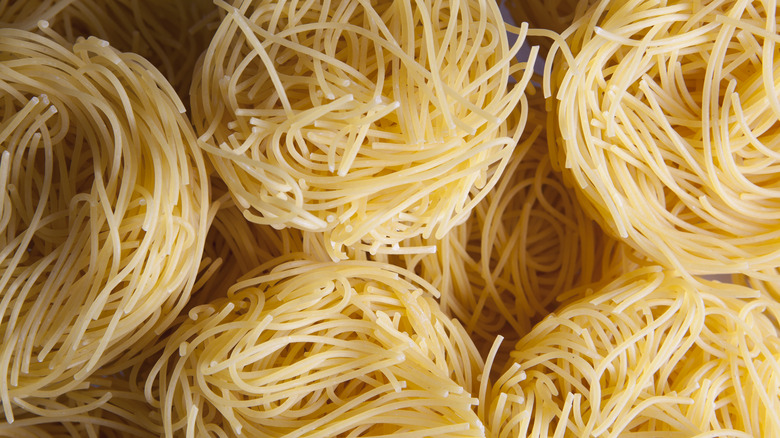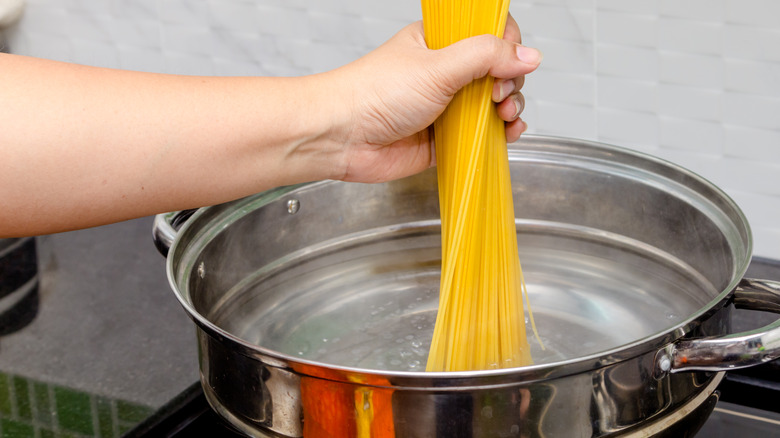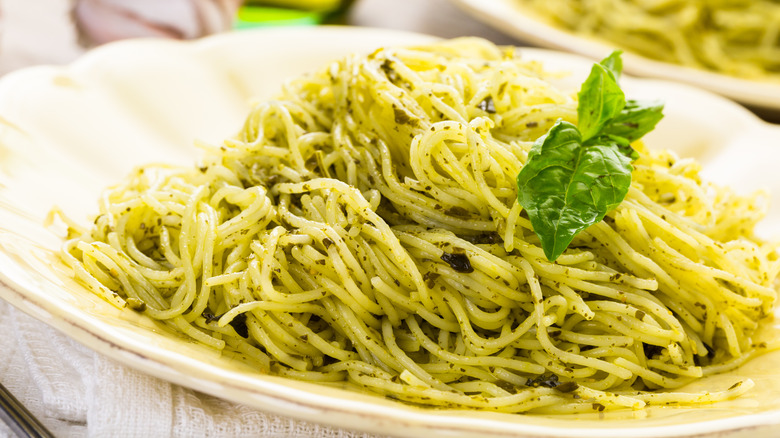Why It's A Mistake To Follow The Box Directions For Angel Hair Pasta
Angel hair pasta, also known as capellini, is a long, thin noodle that resembles spaghetti on a diet. Often sold in nests, angel hair's ultra-thin diameter cooks faster than most pasta types, including tiny shapes like pastina, making it an excellent option for busy weeknight meals. Although package directions suggest cooking the slender pasta between two and four minutes, following the manufacturer's instructions can lead to mistakes.
The window for perfectly cooked angel hair is relatively narrow. Since this variety is so thin, with a diameter ranging from 0.78 to 0.88 millimeters, boiling it just a few seconds too long, let alone two minutes, can result in overcooked pasta instead of the desired al dente texture. Relying on box directions and waiting three minutes to test a noodle for doneness can turn the rest of the pot mushy.
To avoid a disappointing texture, start tasting the pasta after one minute and strain it just shy of the ideal texture, since it will continue cooking in the sauce. For popular brands like DeCecco or Barilla, you might need to shave off 30 seconds to a minute from the recommended cooking time. Once you determine the ideal length, make a note of it, and stick with the same brand for future meals to avoid repeating this process.
Tips for cooking angel hair pasta
A common mistake home cooks make when cooking angel hair is the noodles sticking together. Although this issue can occur with any pasta type, angel hair is more susceptible due to its rapid cooking time. While adding oil or rinsing the pasta after cooking stops the noodles from sticking, this will negatively impact your dish by preventing the sauce from adequately coating each pasta strand.
It's essential to give pasta enough room as it cooks. Angel hair is ultra-thin, so there are more noodles and surface area per pound to absorb water. Choose a pot that can hold roughly six quarts of salted water for every pound of pasta.
Once you add the pasta to the pot, keep an eye on it and stir it regularly. All pasta shapes should be stirred at least three times during cooking: when the pasta is initially added to the pot, in the middle, and at the end. Since angel hair pasta cooks in just a few minutes, it is easy to miss one of these crucial times and end up with a clump of noodles. Spend the few minutes hovering over the stove, stirring the pasta frequently while you finish the sauce. As soon as the pasta is al dente, immediately strain it to prevent overcooking. Don't forget to save some starchy water to help bring the recipe together.
The best recipes for angel hair pasta
Angel hair pasta is best suited for light sauces that come together in the same timeframe. Consider raw sauces made from sweet cherry tomatoes when the produce is at its peak, or coat the delicate strands in sauteed garlic and oil for traditional aglio e olio. A flavorful pesto is another great option, since this type of sauce should only be heated by the cooked pasta. Make a basic pesto sauce using fragrant fresh basil, garlic, pine nuts, parmesan, and olive oil, or try a spicier variation with our sage and arugula pesto recipe.
For a heartier pasta dish, use the time it takes for the water to boil to saute diced guanciale (or pancetta) for pasta alla carbonara. Whether you prefer American or Italian-style carbonara, this classic dish comes together quickly if you prep your ingredients like an Italian restaurant chef. When the pasta goes into the water, scramble your eggs with Pecorino Romano cheese and plenty of freshly ground black pepper, using the reserved pasta water to create the silky sauce.
If you have a pan or deep skillet wide enough for the long noodles to stretch out, try cooking the pasta directly in the sauce instead of boiling water. This method eliminates a step that can prevent overcooking the angel hair, while also infusing the pasta with flavor from the inside.



